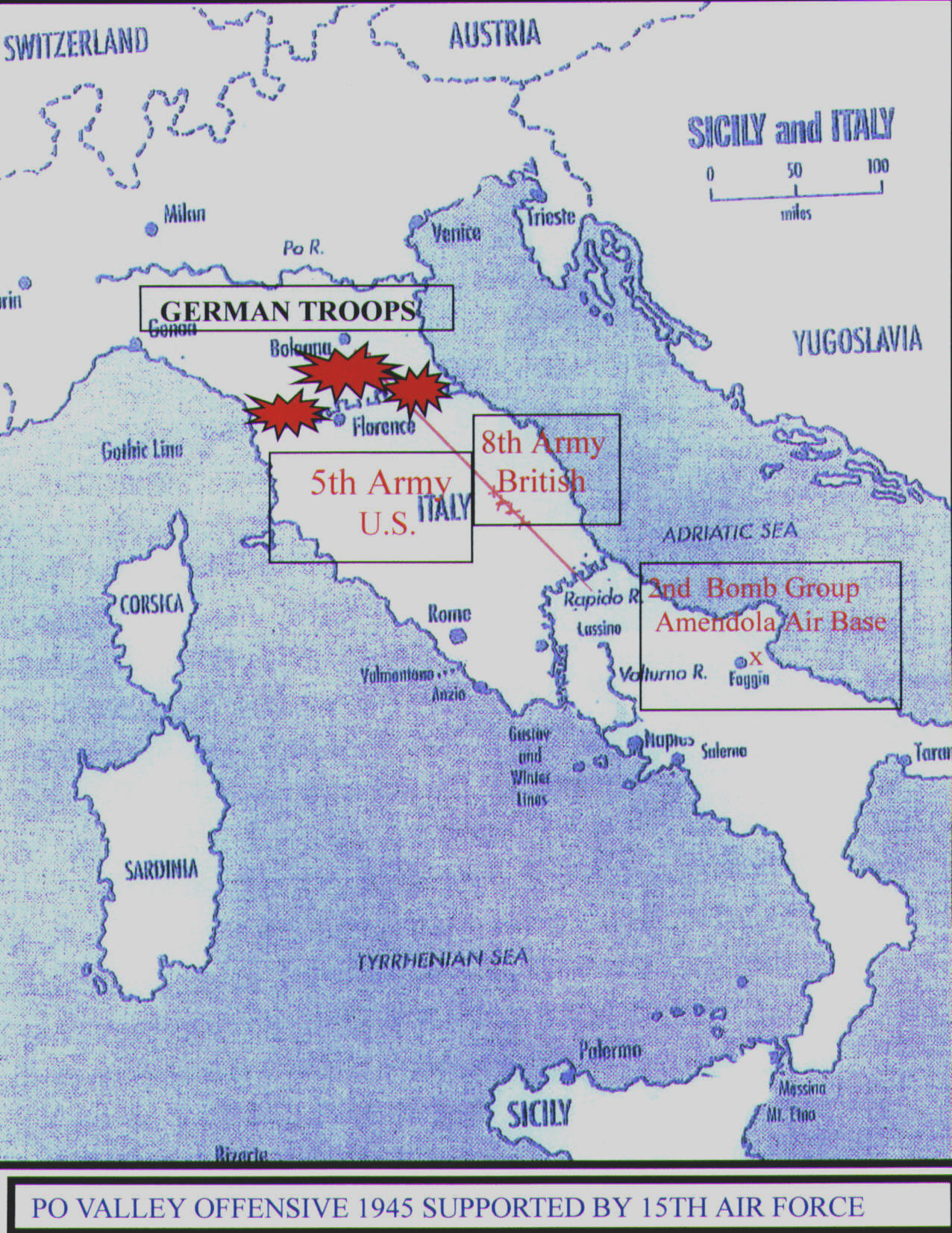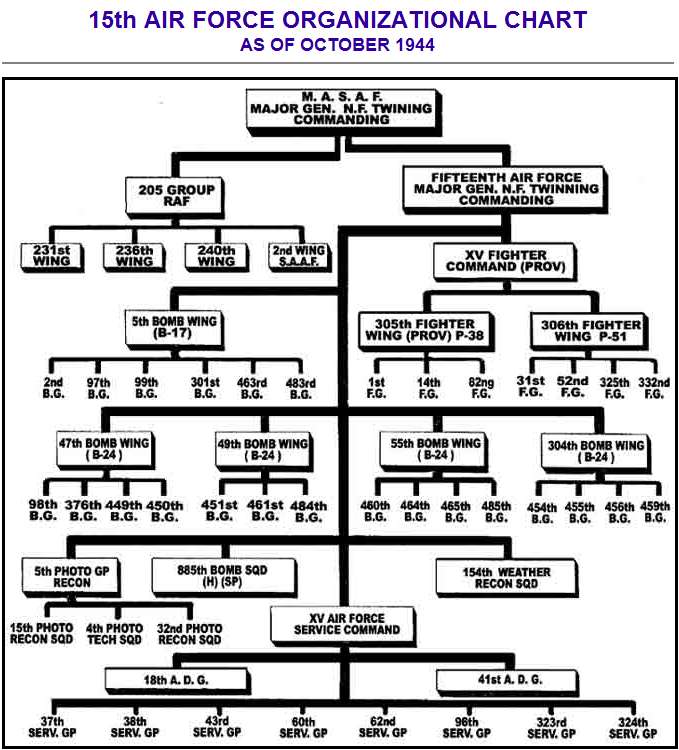15th Air Force - World War II
The Fifteenth Air Force (15th AF) was established on November 1, 1943 in Tunis, Tunisia as part of the United States Army Air Forces in the World War II Mediterranean Theater of Operations as a strategic air force and commenced combat operations the day after it was formed. The first commander was General Jimmy Doolittle.
15th AF resulted from a reorganization of Doolittle's Twelfth Air Force into the 15th with Doolittle in command, and the Ninth Air Force (9th AF) with Lewis H. Brereton in command. The new air force was activated with a strength of ninety B-24 Liberators and 210 B-17 Flying Fortresses, inherited from the Twelfth Air Force and Ninth Air Force. In December, new groups, most of which were equipped with B-24s soon started arriving from the United States. Thirteen new groups were added.
It was hoped that the 15th AF stationed in the Mediterranean would be able to operate when the Eighth Air Force (8th AF) in England was socked in by bad English weather. The 9th AF would later move to England to serve as a tactical unit to take part in the invasion of Europe. Once bases around Foggia in Italy became available, the 15th was able to reach targets in southern France, Germany, Poland, Czechoslovakia, and the Balkans, some of which were difficult to reach from England.
Org Chart from http://www.frankambrose.com/pages/chart.html
15th Air Force Aircraft from "Fifteenth Air Force Story" by Kenn C. Rust
(Note - 5th PRG was a Photo Recon Group and flew the F-5 "Foto" Recon variant of the P-38)
(Note - 154th WRS was Weather Recon Squadron)
The 5th Bomb Wing of the 15th Air Force
The 5th Bomb Wing originated on 19 October 1940 at McChord Field, Washington. Its initial mission was air defense of the northwest United States with three bombardment groups (12th, 17th and 39th) flying early B-17 Flying Fortresses (B-17C/D), as well as the B-18 Bolo and its B-23 Dragon variant.
With the United States' entry into World War II, the mission of the 5th Bomb Wing was changed to that of a strategic heavy bomber wing, in July 1942 being initially assigned to the new Eighth Air Force. However, the 5th Bomb Wing was reassigned to the Twelfth Air Force in October 1942, to support the Western Task Force being assembled for the Operation Torch landings, planned for November.
The 5th moved to North Africa in November, and its subordinate units began flying missions from French Morocco in late 1942. The 97th and 301st Bomb Groups, both being transferred from Eighth Air Force, were the pioneer heavy bomb groups in North Africa.
Three weeks prior to the invasion saw a number of secret missions flown by the 97th BG. The first of these occurred on 18 October 1942 when General Mark Clark, commander of ground forces in the Western Task Force, flew to Gibraltar, along with a box containing $100,000 in gold 20 Franc coins, which were going to be paid to corrupt Vichy France officials in North Africa in order to secure their cooperation during the coming invasion. However after Clark landed in Gibraltar, the coins were lost overboard when they were on the final leg of their journey.
Also, on 5 November General Dwight Eisenhower and British General Kenneth Anderson were flown on a 97th BG B-17 from Britain to Gibraltar. The following day, General James Doolittle, the newly-named commander of Twelfth Air Force was flown to Gibraltar. Doolittle's B-17 was intercepted by four Ju-88s over the Bay of Biscay, forcing the pilot to dive sharply and make a run for it just above the ocean's surface. The co-pilot of the aircraft was injured by a strafing run of one of the German aircraft, and Doolittle reached for the first aid kit and attended to the wounded man. Afterwards, Doolittle sat in the co-pilot's seat and helped fly the aircraft to Gibraltar.
Shortly after the invasion, the 97th and 301st moved from their bases in England to an airfield at Tafraoui, Algeria. The conditions in Algeria were sparse compared to that in England, but on 24 November the two groups attacked the docks at Bizerte, Tunisia.
As the American forces moved eastward, the 5th's units flew from Algeria beginning in January 1943, attacking coastal targets in Tunisia, and also concentrations of Rommel's Africa Corps. The 5th BW moved to Tunisia in August. Targets included airdromes, marshalling yards, bridges, and troop concentrations. In February 1943, the 5th, in direct support of ground operations, bombed enemy troop concentrations in the Kasserine Pass. From its airfields in Tunisia, its subordinate units bombed Pantelleria, Sicily, and marshaling yards and airdromes on the Italian mainland. By October, the 5th Bomb Wing consisted of the two B-17 groups as well as two P-38 equipped fighter groups (1st, 325th FG).
On 1 November 1943, Fifteenth Air Force was established as a second American strategic air force in the European Theater. It was hoped that the 15th AF stationed in the Mediterranean would be able to operate when the Eighth Air Force in England was socked in by bad English weather. The Twelfth Air Force would continue to operate, however it would be realigned as a tactical air force. The 97th and 301st were joined with three additional B-17 groups (2nd, 98th, 99th BG) with its reassignment to the Fifteenth Air Force.
Missions were flown from Tunisia in November against a Messerschmitt assembly plant in Austria, and against some Italian targets, however the wing and its groups were in the process of moving to new airfields captured around Foggia in Italy in late September. Advanced echelons moved initially, working with engineering units to prepare the airfields and extend runways to accommodate the B-17. The 2d Bomb Group moved to Amendola airfield, while the 97th moved to the Foggia airfield, as its base at San Giovanni was still not ready. The 301st flew into Cerignola and the 99th into Tortorella.
Once settled into their new bases around Foggia the 5th began a series of raids, attacking enemy targets in Germany, Austria, Hungary, Yugoslavia, Greece, and Bulgaria. In June 1944, its groups began "shuttle bombing" and landing on airfields behind the Russian front. On these missions, American aircraft took off from airdromes in Italy, made a bombing attack, and landed on airdromes in the Soviet Union. Then they reversed the process. In August 1944, the 5th wing supported the invasion of Southern France.
The 5th Bomb Wing continued strategic bombing missions until the Germans surrendered in May 1945. It was inactivated in Italy on 2 November 1945.
5th Bomb Wing Operational Units
Headquartered: Foggia, Italy, December 13, 1943 – November 2, 1945
- 5th Bombardment Wing (B-17 Flying Fortress) "Y" Tail Code
5th Bomb Wing Tail Markings from "Fifteenth Air Force Story" by Kenn C. Rust
-
-
2nd Bombardment Group "Circle-Y"
-
97th Bombardment Group "Triangle-Y"
-
99th Bombardment Group "Diamond-Y"
-
301st Bombardment Group "Square-Y" (Green)
-
463rd Bombardment Group "Wedge/Pie Slice-Y" (Yellow)
-
483rd Bombardment Group "Y-Star/Star Under Y" (Red)
-
15th Air Force Bases:
Amendola (2nd BG), Celone (463rd BG), Cerignola (97th BG), Foggia (2nd BG, 463rd BG), Lucera (301st BG),
Manduria, (68th RG), Maricianise (97th BG), Sterparone (483rd BG), Torotella (99th BG, 483rd BG)
15th Air Force Bases from "Fifteenth Air Force Story" by Kenn C. Rust
Forward to 2nd Bomb Group





